This post contains affiliate links.
Growing succulents in unique containers such as teacups add charm and character to your indoor garden. These charming succulent-filled teacups look lovely on windowsills or as table centerpieces, and they also make wonderful gifts for family and friends! Another nice thing about them is that they are very easy to make!
You may be wondering if you can successfully grow succulents in teacups. Some succulents such as Hens and Chicks, or Stonecrops are versatile and can be grown in various types of containers. They can successfully be grown in teacups as long as you don’t overwater them. Just water them when the soil is dry.
Let’s go on to explore the enchanting world of succulent teacup gardens starting with their history, the supplies they need, how to plant the succulents, and finally the finishing artistic touches.
Tea Cup Gardens: A History
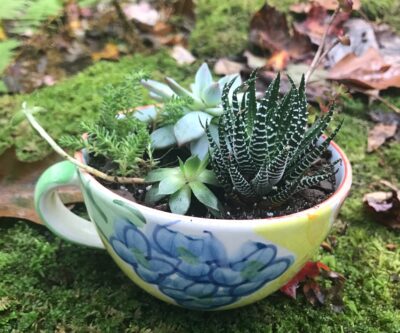
Before getting into the details of how to make your own tea cup garden, let’s take a brief moment to talk about the history of this “art form”. Teacup gardens have their roots in Victorian-era terrariums. In the 1800’s, Nathaniel Bagshaw Ward invented what we know of as terrariums today, (back then they were called Wardian cases), and they became very popular among botanists in that era. Over time they branched off into another type of garden that we call a dish garden. I believe that fairy gardens could be considered another type of dish garden too. Fairy gardens, dish gardens, and terrariums are all still very popular today.
Designing Your Succulent Tea Cup Garden
It really doesn’t take much to make a teacup garden. There are some supplies you will need to gather, but the best and most important part is that you can use your imagination in designing and personalizing each garden you make.
Supplies You Will Need:
- A Pretty Teacup
You want to use a pretty teacup as the planter for your succulents, unless you are going for a “distressed” look and in that case, you would have no problems using a chipped or cracked teacup.
You may already have one on hand, but if you don’t, you can easily find teacups at garage sales or thrift stores for a low price. I didn’t know it until I searched, but Amazon has some you can use for this project if you are interested. - Small Pebbles
You need enough pebbles for a ½ inch layer in your teacup.
You don’t want to use pebbles that would disintegrate over time, or pebbles that would change the pH of the soil.
Aquarium pebbles or some other small-sized river stones would work very well for this purpose.
You can find them in the pet section of your local department store or at a garden center but if you’re interested in finding some online, Amazon has several excellent options as well. - Succulent Soil Potting Mix
You need soil that drains quickly to keep your succulents healthy. We have instructions, found here, on how to make your own soil from scratch but you can also buy your soil locally or even online. This one on Amazon would work well. - Top Dressing
You can use some more of those pebbles used in the bottom of the teacup or some other pretty pebbles or gravel as a top dressing. This adds a nice finishing touch to the display. See our article here for some creative options you can use as top dressings.
Some people choose to use a thin layer of moss as a top dressing for their teacup garden and that may work well with Hens and Chicks or Sedums, but it would not be a good choice if your succulent is a cactus or some other desert succulent since moss tends to hold onto moisture. Succulents don’t like soil that stays wet for too long. - Your Choice of Succulents
You want the succulents to be smaller in size, and not ones that will grow to be quite large. You can choose succulents of different heights to create depth and add visual interest to your arrangement.
Usually you can find succulents at a garden center, but Amazon has a good selection succulents such as Hens and Chicks, Sempervivum, and Sedums,(also known as Stonecrops).
These types of succulents work very well in planters like this.
How to Make Your Succulent Teacup Planter
- Wash your teacup to remove any residue there may be on it. This is important especially if you bought it at a garage sale or a thrift store. Some residues may be harmful to your succulents!
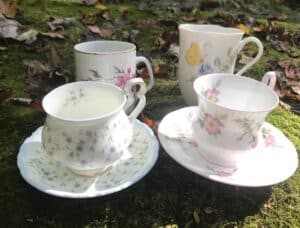
- It is not necessary to drill a hole in the bottom of the cup for drainage. If you don’t have a hole for drainage, just water it the way you would water an open terrarium.
If you want drainage holes, then now is the time to carefully drill 1-3 holes into the bottom of the teacup.
(Here’s a video that shows you how to drill a hole in your container.)

- Put about ½ inch of the small pebbles into the bottom of the teacup. This is necessary if you don’t have drainage holes in the cup since it helps with drainage.
- Fill the cup about ⅔ full with the succulent soil mix.
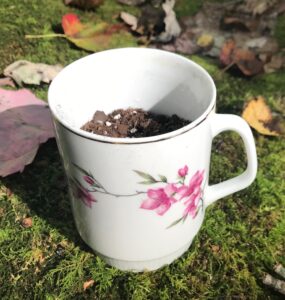
- Scoop a hole in the soil where you want to plant your succulent.
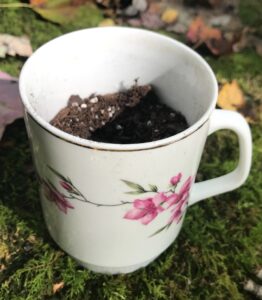
- Remove the succulent from its original container and gently shake off/ remove the excess soil.
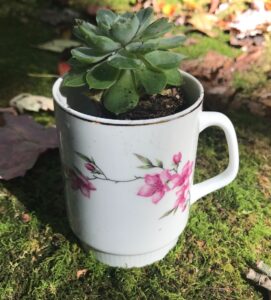
- Plant it in the hole that you made in step 5 and gently add more soil around it if needed. Press gently but don’t pack the soil. Succulents like loose, aerated soil.
- Water the plant. Don’t add more than necessary since succulents don’t like their roots to be sitting in water. Let the soil dry completely before watering again.
- Add a Top Dressing
As a finishing touch, you can add a top dressing. This is optional, but it adds to the visual appeal of your display.
There are lots of top dressings you can choose from. See our article (here) for some ideas.
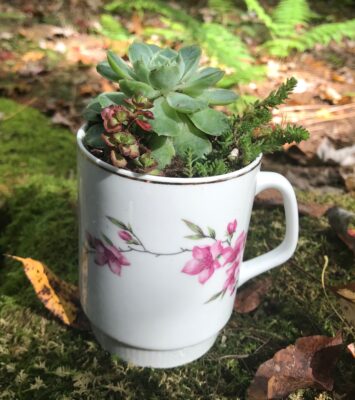
- Place your teacup garden where there is bright but indirect light.
This video shows how simple it is to make a succulent teacup garden as well as what beautiful gifts they make.
This post was written for cactus-central.com and is not permitted to be used on other sites.
